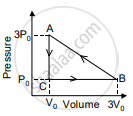Advertisements
Advertisements
प्रश्न
Write a note on free expansion.
उत्तर
- Free expansions are adiabatic expansions thus there is no exchange of heat between a system and its environment.
- Also, there is no work done on the system or by the system. Q = W = 0, and according to the first law of thermodynamics, ΔU = 0.
- For example, when a balloon is ruptured suddenly, or a tire is suddenly punctured, the air inside rushes out rapidly but there is no displacement of a piston or any other surface.
- A free expansion is different than other thermodynamic processes because it is an uncontrolled change. It is an instantaneous change and the system is not in thermodynamic equilibrium.
- A free expansion cannot be plotted on a p-V diagram. Only it's initial and the final state can be plotted.
APPEARS IN
संबंधित प्रश्न
Explain why The climate of a harbour town is more temperate than that of a town in a desert at the same latitude.
A thermodynamic system is taken from an original state to an intermediate state by the linear process shown in Figure

Its volume is then reduced to the original value from E to F by an isobaric process. Calculate the total work done by the gas from D to E to F
Answer in brief.
Why should a Carnot cycle have two isothermal two adiabatic processes?
Draw a p-V diagram of the irreversible process.
Draw a p-V diagram showing negative work with varying pressure.
Draw a p-V diagram showing positive work at constant pressure.
Explain the cyclic process.
3 mole of a gas at temperature 400 K expands isothermally from an initial volume of 4 litres to a final volume of 8 litres. Find the work done by the gas. (R = 8.31 J mol-1 K-1)
When you exercise in the morning, by considering your body as a thermodynamic system, which of the following is true?
The V-T diagram of an ideal gas which goes through a reversible cycle A→B→C→D is shown below. (Processes D→A and B→C are adiabatic)

The corresponding PV diagram for the process is (all figures are schematic)
Apply first law for an isothermal process.
What is a cyclic process?
Explain in detail the isothermal process.
Explain in detail an adiabatic process.
Derive the work done in an adiabatic process.
Explain the isobaric process and derive the work done in this process.
Explain in detail the isochoric process.
In an adiabatic expansion of the air, the volume is increased by 4%, what is the percentage change in pressure? (For air γ = 1.4)
For a given ideal gas 6 × 105 J heat energy is supplied and the volume of gas is increased from 4 m3 to 6 m3 at atmospheric pressure. Calculate
- the work done by the gas
- change in internal energy of the gas
- graph this process in PV and TV diagram
A monoatomic gas of pressure p having volume V expands isothermally to a volume 2V and then adiabatically to a volume 16V. The final pressure of the gas is ____________.
`("ratio of specific heats" = 5/3)`
In which of the following processes, beat is neither absorbed nor released by a system?
Ideal gas for which 'ϒ' = 1.5 is suddenly compressed to `1/4`th of its initial volume. The ratio of 4 the final pressure to the initial pressure is ______.
`(ϒ = "C"_"p"/"C"_"v")`
In the figure shown here, the work done in the process ACBA is ______.

Explain the thermodynamic process.
